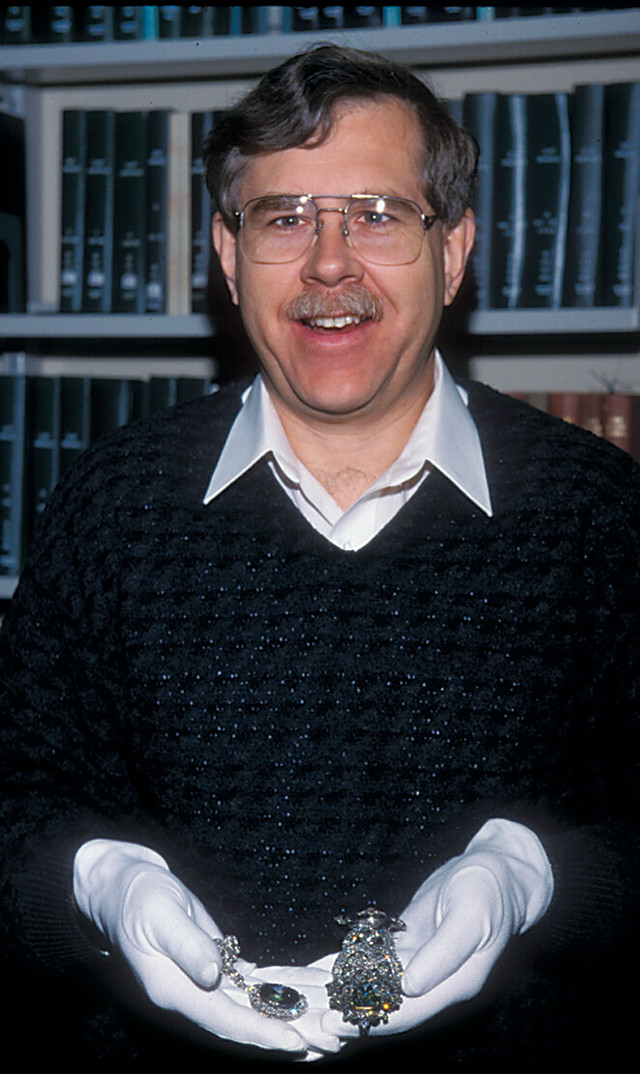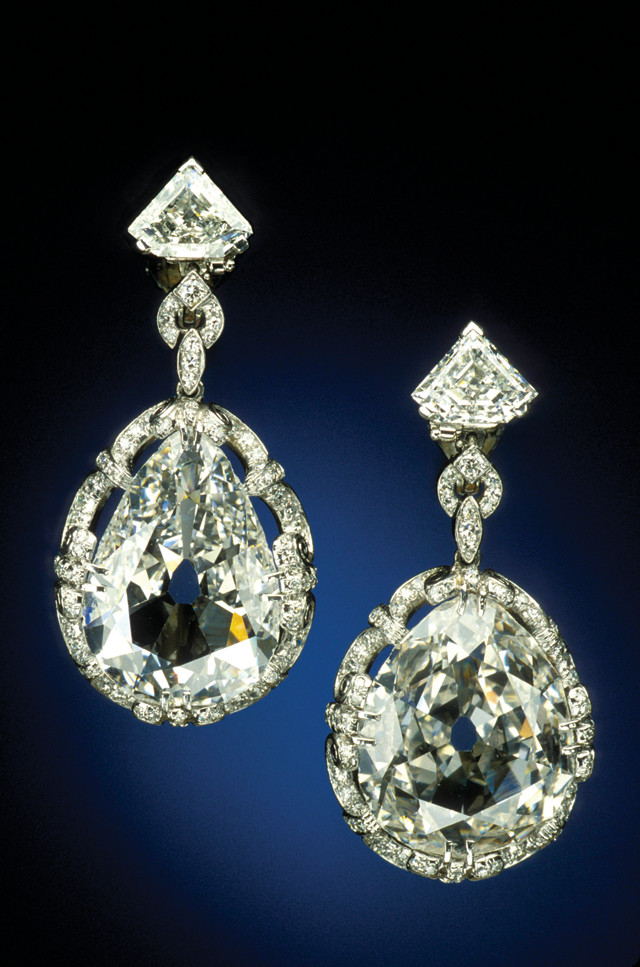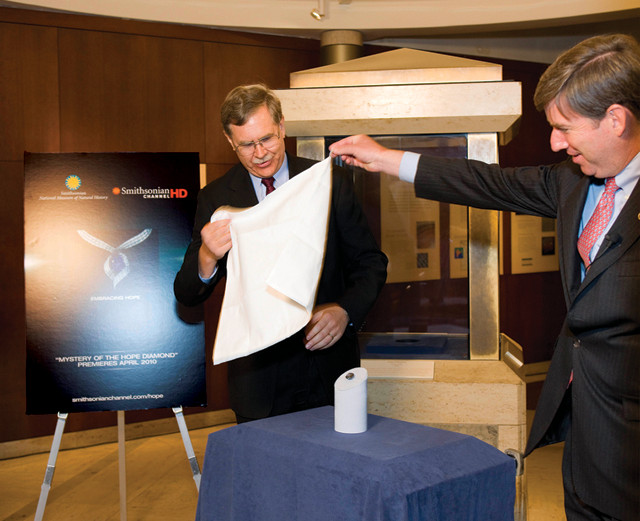
by Meg Marquardt Tuesday, May 22, 2018

Jeffrey Post has been the curator of the Smithsonian's National Gem and Mineral Collection for more than two decades. Credit: Smithsonian Institution
The gems and minerals exhibit at the Smithsonian Institution’s National Museum of Natural History in Washington, D.C., has more than 3,000 pieces; the entire collection has more than 360,000 pieces. From slabs of granite to the ultimate gem, the Hope Diamond, the collection is one of the finest displays of geology in the world. And one person, Jeffrey Post, oversees the entire collection. As the curator of the National Gem and Mineral Collection for the past 20 years, Post has helped obtain some of the collection’s most stunning pieces as well as pursued research behind the scenes. Post sat down with Meg Marquardt, an intern at EARTH, to talk about his path to the Smithsonian, the charm of the collection and his research into environmentally important minerals.
MM: How did you get started in mineralogy?
JP: In all honesty, my path started very early. I grew up in a small town in Wisconsin and I was one of those kids always out wandering around the fields and quarries collecting fossils. I always found something to bring home, some kind of rock or fossil. We weren’t very far from the lead and zinc mining areas, so as I got older, I went to collect minerals in those areas. So I was a fairly passionate gem, rock and mineral collector from an early age. I was lucky because my dad had an interest as well, and some teachers and neighbors were into it, so I had a lot of people who could reinforce and facilitate my interest in geology.
MM: Why did you focus on mineralogy?
JP: What kept me interested in minerals more than other aspects of geology was partly my interest in chemistry. Minerals are just natural chemical compounds, so all the things that you learn about in chemistry are happening on a bigger scale in the Earth. But I was always fascinated by crystals. When you see these things, each one just seems like a miracle of nature.

These diamonds were supposedly worn by Marie Antoinette. Post and his colleagues are currently investigating whether these diamonds really belonged to the French queen. Credit: Chip Clark, Smithsonian Institution
MM: How did you end up at the Smithsonian?
JP: Eventually, you have to find a job. In 1983, the second year of my post-doc at Harvard, I started looking at everything that was open in university positions. But then, lo and behold, there was this position for a mineralogist at the Smithsonian, and it had never occurred to me that this could be a place I could work or would want to work. I didn’t really know what they even did [at the Smithsonian]. But I applied here … and eventually was offered a job. And then I had to go through the agonizing decision of whether to follow the path [in academia] that I’d always imagined or try something different. In the end, the job was just too good to turn down. And now most days I pinch myself; now it’s hard to think that I ever thought about not taking this job.
MM: Why do you think visitors to the museum enjoy the mineralogy exhibit so much?
JP: Part of what makes the gem collection so interesting to people is this nice confluence of the natural history and human history. Each of the pieces in the gem collection has a natural history of being a crystal that was formed in the earth, and then it has the human side — the skill of the cutter to cut it, the skill of a jeweler to make a piece of jewelry, and then the stories of the people who owned the gems. Because gems are practically indestructible, they get passed on and accumulate stories; so that combination of natural and human stories makes these gems different from anything else we have in the museum.
The gems are a great way to invite people into the exhibition. If you hang up a sign that says “Geology Exhibit,” no one comes. But if you call it the gem collection, people are intrigued. Most people come in and want to see the Hope Diamond straight away, so we put it right up front. We try to use the gem gallery to start to introduce people to some concepts of geology, such as what crystals and minerals are. A lot of people who come in here, amazingly, have never really thought about where gems come from. By the time they’re done in the gem gallery, I think people are intrigued and want to know more about where gems come from, so it’s a nice way to get people into the topic of geology.

Post and Cristián Samper, director of the Smithsonian National Museum of Natural History, unveiled the Hope Diamond, being shown out of its setting in September 2009. Credit: Chip Clark, Smithsonian Institution
MM: What is your favorite piece in the Smithsonian collection?
JP: That’s a hard one. On any given day, I could fall in love with anything in the collection. But one of the pieces I find intriguing is this diamond crystal called the Oppenheimer diamond. It’s a natural diamond crystal right out of a mine in South Africa. It’s one of the great diamond crystals that has survived cutting. It’s something that we can show the public and give them a sense of what a diamond really looks like. So that’s always been a special piece to me.
MM: Besides your curator duties, what do you spend your time doing?
JP: Research. Structures and behaviors of minerals are where my research focuses. My interest is with minerals at the surface of the Earth rather than deep-earth or the high-temperature, high-pressure minerals. I am interested in minerals that are at the interface between the solid earth and water and air and life.
In recent decades, there’s been a realization that minerals don’t just exist separate from living things — instead, there are interactions between minerals and Earth’s biological community. When I took geology, we were taught that minerals were inorganic, and you just didn’t talk about biology. And now, more and more, to be a really good mineralogist, you have to take biology classes. Clearly, things aren’t as clear-cut as we thought.
MM: What are you working on now?
JP: I’m working on a couple of things right now, spanning the mineralogical spectrum. On one hand, there is the [aforementioned] environmental mineralogy, and on the other, there’s diamonds.
We are interested to learn what natural diamonds tell us about how they were formed, what conditions they’ve been exposed to from the time they formed in the upper mantle until the time they reached Earth’s surface. One of the focuses is what sort of defects are in natural diamonds that might give rise to a pink color. We don’t actually know for sure why certain diamonds take on a pink shade, but we think it has to do with defects in the diamond’s structure due to stresses applied to the diamond deep in the earth and perhaps as it is carried to the surface by a volcanic eruption.
Also, we’re looking at blue diamonds, for obvious reasons as we have the Hope Diamond. One of the projects we’re working on is measuring the amount of boron that is in the diamonds. [Atoms of boron replacing some of the diamond’s carbon atoms causes the blue shade.] We actually had the Hope Diamond out of its setting and on a machine to study this.
MM: What about the environmental mineralogy?
JP: I’m looking at minerals called manganese oxides. If you ever go out to the Southwest or to the deserts, you’ll see on the surface of the rocks a dark coating called rock varnish; the dark color is due to manganese oxides. They’re found in most soils … but they’re not well-studied. People used to pick up the black gunk and sort of went, “Yep, manganese oxide,” and set the rock to the side without really ever studying it.
Nowadays, we have the tools to let us look at these minerals in better detail. We’re looking at what their structures are, and more importantly, what their behaviors are. We can watch what the reactions of minerals are to various stimuli in real time, so we can better understand how these minerals are behaving in similar conditions in our environment.
We want to understand how minerals behave in the part of the world that we directly interact with, because these minerals are, every day, affecting the composition of the waters that we swim in or drink, and affecting the living things like plants that live on them. It’s a much bigger, more complex story than I think anyone ever imagined.

The Hope Diamond, at 45.52 carats, is the centerpiece of the Smithsonian's gem collection. It has been at the museum since 1958. Credit: Smithsonian Institution
© 2008-2021. All rights reserved. Any copying, redistribution or retransmission of any of the contents of this service without the expressed written permission of the American Geosciences Institute is expressly prohibited. Click here for all copyright requests.